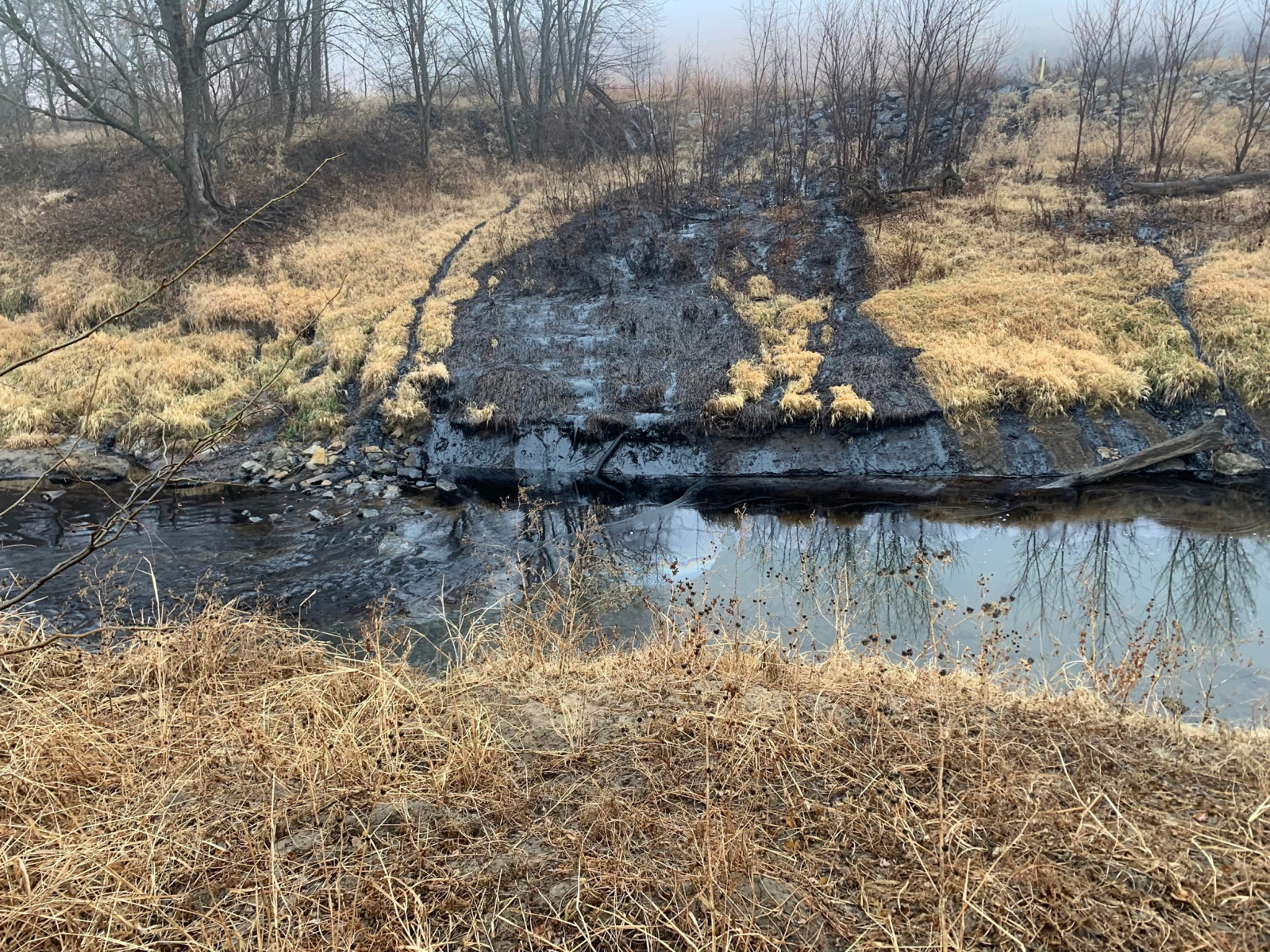The second-largest tar sands oil spill in the country — which left a black pockmark on Kansas grasslands a few weeks ago — will be harder to clean compared to past oil spills.
In early December, nearly 14,000 barrels of oil known as diluted bitumen spilled in north-central Kansas, three hours outside of Kansas City, Kansas. The cleanup is still underway, with at least 4,000 barrels now cleared from a waterway known as Mill Creek. But as time goes on, environmentalists and infrastructure experts worry about the oil that will be more difficult to clean.
According to TC Energy ,the Canadian operator of the Keystone Pipeline responsible for the spill, other sections of the pipeline have been restarted at reduced pressure. At the time of the spill, the pipeline was operating at 80 percent of the maximum recommended rate, which is allowed under a 2007 permit granted to the pipeline company by the federal Pipeline and Hazardous Materials Safety Administration, or PHMSA. Normally, crude oil pipelines can’t operate above 72 percent of this rate. To be granted the exception, TC Energy had to “construct the pipeline using higher-grade steel,” according to a report from the Government Accountability Office.
Diluted bitumen, or dilbit, is a natural oil sand found in sand deposits. It’s composed of sand, water, and bitumen, a sticky, black petroleum. According to an Inside Climate News analysis, dilbit is the heaviest of the crude oils used today and 50 to 70 percent of its composition is likely to sink in water, compared to the less than 10 percent of most crude oils. The oil inside the Keystone Pipeline is transported from the tar sands of Alberta, Canada — the globe’s third largest petroleum reserve — to refineries in the Midwest and the Gulf Coast. The leak occurred on a section of the Keystone Pipeline completed in 2011.
“It is troubling to see so many failures and so much oil spilled from any pipeline, but it is especially troubling from such a relatively new pipeline,” Bill Caram, executive director of the nonprofit pipeline watchdog group Pipeline Safety Trust, said in a statement.
According to a report from the National Academy of Sciences, dilbit is harder to clean, coats and adheres to landscapes and animals more than other crude oils, and has a smaller window of opportunity for proper cleanup. This study was commissioned by Congress after the infamous 2010 Kalamazoo, Michigan oil spill, where nearly 42,000 barrels of dilbit spilled into a tributary of the Kalamazoo River from an Enbridge-operated pipeline. This oil spill, which took four years and billions of dollars to clean up while also prompting the evacuation of hundreds of homes, was the worst tar sands oil spill in the nation’s history.
So far, 71 fish and four mammals have been confirmed killed in the Kansas oil spill, with one beaver saved by rescue crews, according to the Environmental Protection Agency, or EPA. After the initial spill, TC Energy created two dams to prevent any continued spread and has since been working to remove the tar sands oil from surface water. According to the EPA, no drinking water wells were affected by the spill, but the federal agency and the Kansas Department of Health and Environment have urged people and animals to avoid the contaminated creek.
“We continue to prioritize the safety of people and the environment,” TC Energy said in a statement. “We are working with wildlife assessment crews including state and federal wildlife trustees and have trained professional responders onsite to identify any impacts to wildlife.”
The company has previously paid over $300,000 in fines related to damage caused by the Keystone Pipeline.
The Keystone Pipeline, and its now-defunct offshoot Keystone XL, have sparked battles from local communities and Indigenous people in the nation’s prairie lands since its inception. In 2011, then-Nebraska Governor Dave Heineman urged the federal government to stop the expansion of the pipeline through his state to protect water. When the Keystone XL segment was announced, federal and local law enforcement began to strategize about how to stop Indigenous protests in Montana, South Dakota, and Nebraska “by any means.”
The ruptured Kansas segment of the pipeline remains closed during the cleanup process. In a statement, TC Energy said it continues to work with the PHMSA to determine the cause of the ruptured line. President Joseph Biden recently released 2 million barrels of oil from the nation’s strategic reserve to various refineries in hopes of preventing “potential supply disruptions” caused by the spill.
*Correction
This story has been updated to describe Pipeline Safety Trust as a nonprofit public watchdog group.



